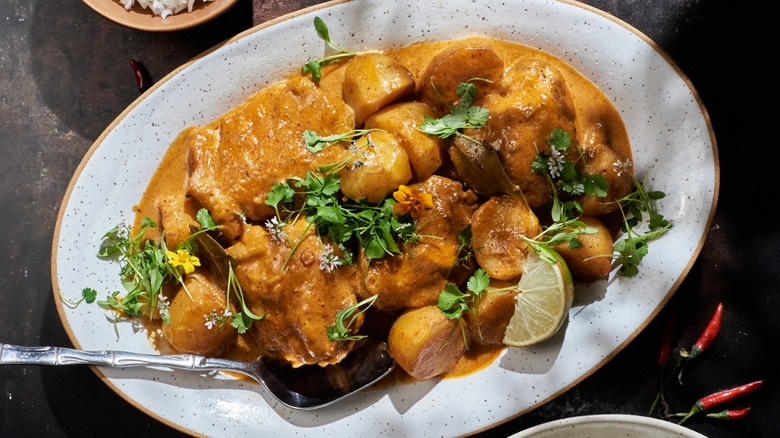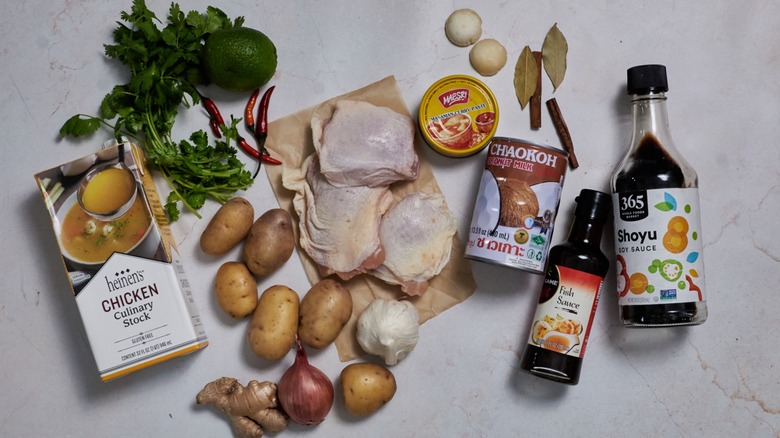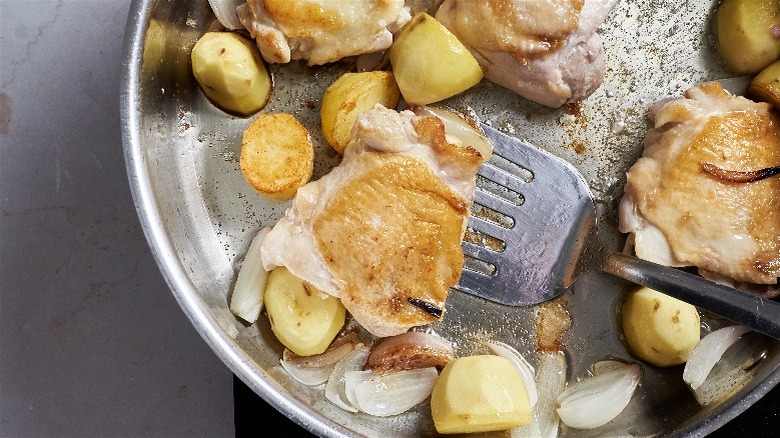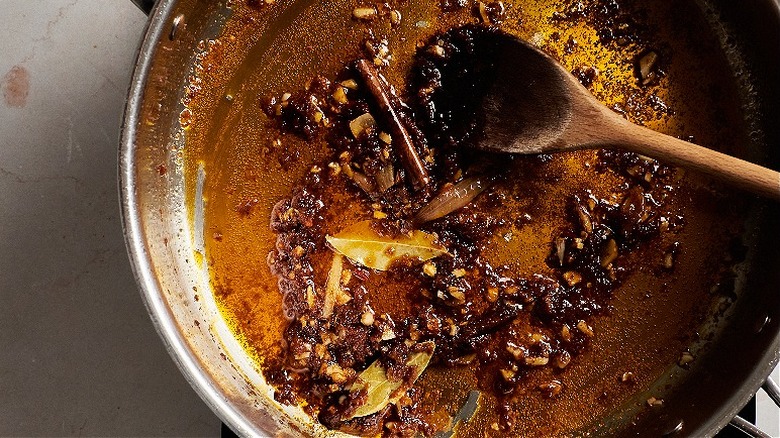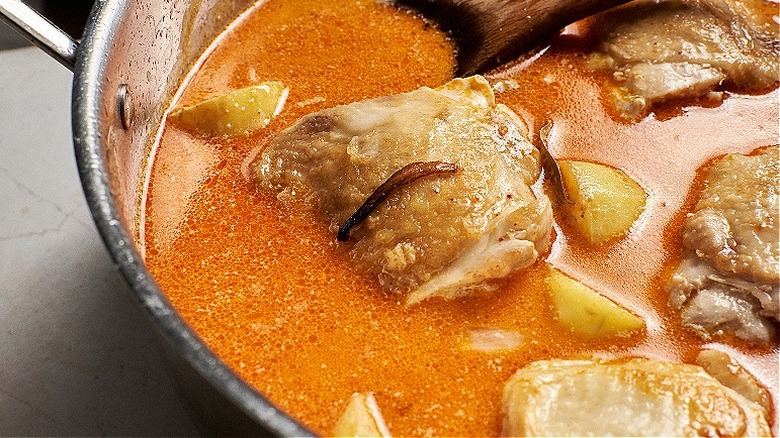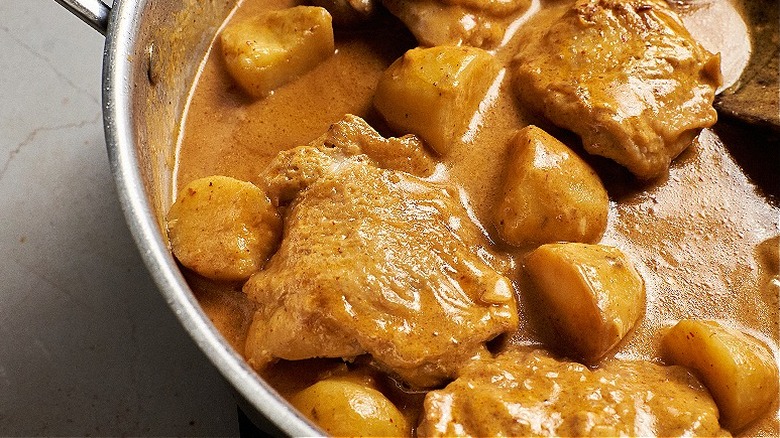Chicken Massaman Curry Recipe
We tend to think of India when we think of curry thanks to the hundreds of saucy, rich dishes so famous in the cuisine. However, Thailand also boasts a delicious variety of curries influenced by its robust cultural diversity. Indian traders shared spices, aromatics, and herbs, while Portuguese merchants offered the chilies so notable in Thai dishes today. Despite such direct influence, Thai curries differ slightly from their Indian counterparts, usually being a little thinner, involving sweet and sour flavors, and utilizing ingredients more common in Thailand, like soy sauce and fish sauce. While Indian curry may be rich, buttery, and tomatoey, Thai curry is likely to be a little sweet, with citrusy undertones and a lot of sauce. Side by side, the differences are notable; but at the end of the day, it's all curry.
This recipe shared by Michelle McGlinn is a little different from the typical red, green, and yellow curry so often found on takeout menus. If you're lucky, your favorite takeout spot might have Massaman curry on the menu, a curry known for a specific flavor of cinnamon, coconut, and mild heat. It's creamier and less spicy than red curry, leaning on warm spices and curry paste rather than chiles for its flavor. It's also super easy to put together, making it a perfect weeknight dinner and a winner for the whole family.
Everything you need for chicken Massaman curry
For this curry, you'll need bone-in, skin-on chicken thighs. These will be the most tender and flavorful, but if you would rather use boneless, skinless thighs or breasts, those will work, too. You'll also need gold potatoes, which are the creamiest — we used size B potatoes, which are about half the size of regular Yukon golds, but you can use smaller new potatoes or quartered Yukon golds if you prefer. For either of these swaps, adjust the cook time accordingly so the chicken is fully cooked and the potatoes are completely soft.
You'll also need a shallot, a small piece of ginger, some garlic, a few red Thai chiles, cinnamon sticks, bay leaves, and Massaman curry paste. This is a specific type of curry paste and will say so on the packaging. It's also a little hard to find in bigger grocery stores, so check your local Asian market in the Thai sections (You'll also likely find the Thai chiles here, too).
For the curry sauce, you'll need a can of coconut milk, chicken stock, soy sauce, fish sauce, palm sugar, and cilantro. You can swap in white sugar for palm sugar, but this sugar is a little less sweet and tastes almost buttery, which adds more richness than regular sugar would. If you're seeking out Massaman curry paste, the palm sugar will be nearby. Give it a try.
Brown the chicken and potatoes
This step is technically skippable if you're in a big rush, but it only takes a few minutes and develops a lot of flavor and structure for the final result. Place the chicken and potatoes skin and cut sides down in the skillet and brown them, without touching them, until they're deeply browned (and a little charring is even okay). Sprinkle the sliced shallots around the chicken and potatoes to soften those at the same time, then remove everything from the skillet. If your skillet is small, work in batches, browning the chicken first, then the potatoes, then the shallots.
Develop the base of the curry
This step is not that different from developing a pasta sauce or mixing together a creamy soup. Soften the aromatics first, then mix the curry paste in to combine and caramelize. Add the cinnamon sticks and bay leaves here so they can toast slightly before any coconut milk is added, opening up their flavors. Once everything is soft, combined, and beginning to turn brown, pour in the coconut milk. Whisk vigorously to combine the curry paste smoothly into the coconut.
Simmer the chicken
Add the chicken, potatoes, and shallots to the coconut mixture, then cover with chicken stock or water. The chicken doesn't have to be completely covered, but add enough stock so that about ¾ of the chicken is submerged. Bring the mixture to a simmer on medium low heat and cook until the potatoes are very soft, the chicken is fall-apart tender, and the curry is thick. This will take about 20 minutes, which you can spend making rice to serve the curry with.
Add the remaining flavor and serve
Instead of adding salt and pepper the curry, season it with soy sauce, fish sauce, sugar, and lime. The curry should already be plenty spicy from the Thai chiles added at the beginning, and to tame that spice a bit, squeeze in some lime and drop in some sugar. Palm sugar usually comes in solid pieces, so use about a tablespoon's worth and dissolve it directly in the curry. For umami and salty flavor, add the soy sauce and fish sauce. Taste the curry: If it's too spicy, add a little more lime. If it's too bland, add a few more splashes of soy sauce.
To serve the curry, sprinkle it with cilantro and ladle over rice. You can also serve topped with roasted peanuts for added crunch. And like your favorite takeout, the leftovers keep well in the fridge and are almost even better the next day. Once you source the ingredients, this curry comes together so easily and is delicious served alongside spring rolls, edamame, and crab rangoon. Takeout? Never heard of her.
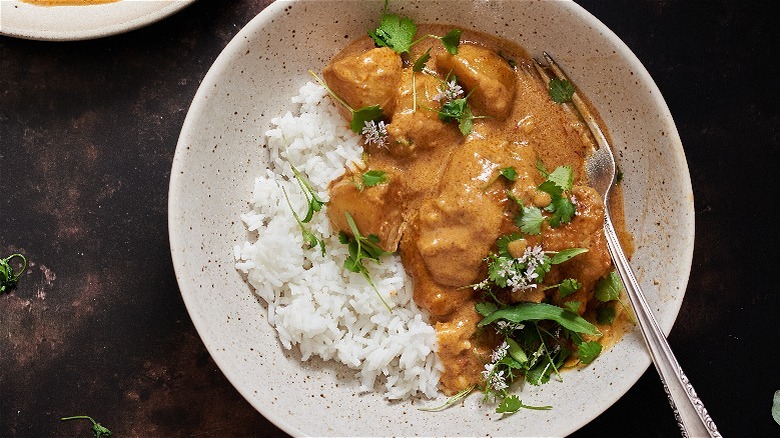
- 1 pound bone-in, skin-on chicken thighs
- ½ pound size B gold potatoes, peeled and halved
- 1 large shallot, quartered then halved
- 1 inch fresh ginger, peeled and minced
- 3 cloves garlic, minced
- 2 small Thai chiles, finely chopped
- 3 tablespoons Massaman curry paste
- 2 sticks cinnamon
- 2 bay leaves
- 1 (13.5-ounce) can coconut milk
- 1 ½ cups chicken stock or water
- 1 ½ tablespoons soy sauce
- 1 ½ tablespoons fish sauce
- 1 tablespoon palm sugar
- Juice from ½ lime
- Cilantro, for garnish
- Add the chicken skin-side down to an oiled, deep skillet. Add the potatoes cut side down, then add the shallot pieces. Brown over medium heat until chicken skin is brown and crispy and the potatoes are golden on the bottom, about 5 minutes. Remove from the skillet.
- Add more oil if needed, then sauté the garlic, ginger, and chiles until soft and fragrant, about 2 to 3 minutes. Once soft, stir in the curry paste and combine. Add the cinnamon sticks and bay leaves.
- Shake the coconut milk well and pour it into the skillet, whisking or stirring to combine with the curry paste. Add the chicken, potatoes, and shallot back into the skillet, then add the chicken stock. Chicken stock should cover ¾ of the chicken thighs.
- Bring the curry to a simmer and cook, uncovered, until chicken is fall-apart tender and potatoes are very soft, about 15 to 20 minutes.
- Once chicken and potatoes are tender, add the soy sauce, fish sauce, palm sugar, and lime juice and stir. Stir the palm sugar to dissolve. Cook for another 5 minutes, stirring frequently.
- To serve, garnish with cilantro and serve over rice.
| Calories per Serving | 570 |
| Total Fat | 41.3 g |
| Saturated Fat | 23.7 g |
| Trans Fat | 0.1 g |
| Cholesterol | 114.9 mg |
| Total Carbohydrates | 27.5 g |
| Dietary Fiber | 3.7 g |
| Total Sugars | 7.5 g |
| Sodium | 1,164.2 mg |
| Protein | 26.6 g |
